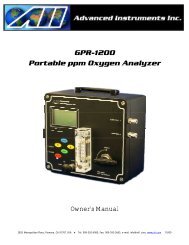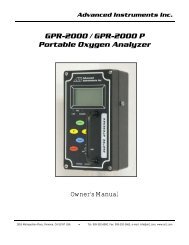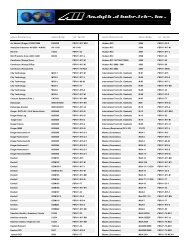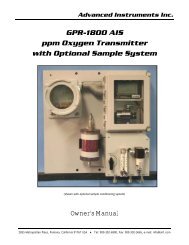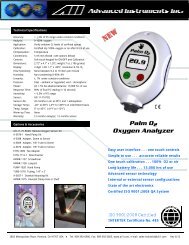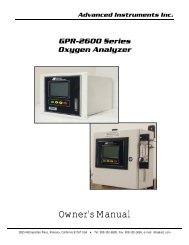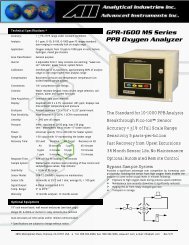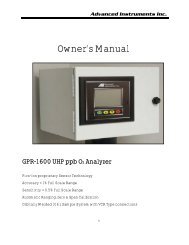GPR-18 MS ATEX Explosion Proof PPB Oxygen Analyzer.
GPR-18 MS ATEX Explosion Proof PPB Oxygen Analyzer.
GPR-18 MS ATEX Explosion Proof PPB Oxygen Analyzer.
- No tags were found...
Create successful ePaper yourself
Turn your PDF publications into a flip-book with our unique Google optimized e-Paper software.
Advanced Instruments Inc.damage to the sensor or optional components. Consult the factory for recommendations concerning the proper selection andinstallation of components.Expected Sensor Life: With reference to the publish specification located in section 4 of this manual, the expected life of alloxygen sensors is predicated on oxygen concentration (< 1000 ppm or air), temperature (77°F/25°C) and pressure (1atmosphere) in “normal” applications. As a rule of thumb sensor life is inversely proportional to changes in the parameters.Deviations are outside the specifications and will affect the life of the sensor, with respect to Pico-Ion sensors avoid exposure tooxygen levels above 1000 ppm. Failure to do will result in damage to the sensor.Accuracy & Calibration: Refer to section 5 Operation, Calibration. <strong>Analyzer</strong>s equipped with Pico-Ion oxygen sensors have amaximum range of 0-1000 ppm reflecting its high signal output capability, DO NOT CALIBRATE THE <strong>GPR</strong>-<strong>18</strong><strong>MS</strong> WITH AIR.Materials: Assemble the necessary zero, purge and span gases and optional components such as valves, coalescing orparticulate filters, and, pumps as dictated by the application; stainless steel tubing is essential for maintaining the integrity ofthe gas stream for ppm and percentage range (above or below ambient air) analysis; hardware for mounting.Operating Temperature: The sample must be sufficiently cooled before it enters the analyzer and any optional components.A coiled 10 foot length of ¼” stainless steel tubing is sufficient for cooling sample gases as high as 1,800ºF to ambient. Themaximum operating temperature is 45º C on an intermittent basis unless the user is willing to accept a reduction in expectedsensor life – refer to analyzer specification - where expected sensor life is specified at an oxygen concentration less than 1000ppm oxygen for ppm analyzers and air (20.9% oxygen) for percent analyzers, but in all instances at 25°C and 1 atmosphere ofpressure. Expected sensor varies inversely with changes in these parameters.Pressure & FlowAll electrochemical oxygen sensors respond to partial pressure changes in oxygen. The sensors are equally capable of analyzingthe oxygen content of a flowing sample gas stream or monitoring the oxygen concentration in ambient air (such as a confinedspace such in a control room or an open area such as a landfill or bio-pond). The following is applicable to analyzersequipped with galvanic oxygen sensors, <strong>GPR</strong>-<strong>18</strong> and <strong>GPR</strong>-28. With respect to analyzers equipped with Pico-Ionoxygen sensors, <strong>GPR</strong>-<strong>18</strong><strong>MS</strong> refer to the analyzer’s specifications in section 4.<strong>Analyzer</strong>s designed for in-situ ambient or area monitoring have no real inlet and vent pressure because the sensor is exposeddirectly to the sample gas and intended to operate at atmospheric pressure, however, slightly positive pressure has minimaleffect on accuracy.Inlet Pressure: <strong>Analyzer</strong>s designed for flowing samples under positive pressure or pump vacuum (for samples at atmosphericor slightly negative atmospheres) that does not exceed 14” water column are equipped with bulkhead tube fitting connectionson the side of the unit (unless otherwise indicated, either fitting can serve as inlet or vent) and are intended to operate atpositive pressure regulated to between 5-30 psig although the rating of the fitting itself is considerably higher. Caution: If theanalyzer is equipped with an optional H2S scrubber, inlet pressure must not exceed 30 psig.Outlet Pressure: In positive pressure applications the vent pressure must be less than the inlet, preferably atmospheric.Sample systems and flowing gas samples are generally required for applications involving oxygen measurements at a pressureother than ambient air. In these situations, the use of stainless steel tubing and fittings is critical to maintaining the integrity ofthe gas stream to be sampled and the inlet pressure must always be higher than the pressure at the outlet vent which isnormally at atmospheric pressure. Flow Through Configuration: The sensor is exposed to sample gas that must flow or bedrawn through metal tubing inside the analyzer. The internal sample system includes 1/8” compression inlet and vent fittings, astainless steel sensor housing with an o-ring seal to prevent the leakage of air and stainless steel tubing.Flow rates of 1-5 SCFH cause no appreciable change in the oxygen reading. However, flow rates above 5 SCFH generatebackpressure and erroneous oxygen readings because the diameter of the integral tubing cannot evacuate the sample gas atthe higher flow rate. The direction the sample gas flows is not important, thus either tube fitting can serve as the inlet or vent –just not simultaneously.A flow indicator with an integral metering valve upstream of the sensor is recommended as a means of controlling the flow rateof the sample gas. A flow rate of 2 SCFH or 1 liter per minute is recommended for optimum performance.6



